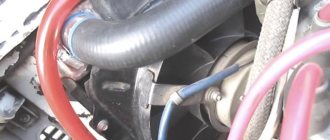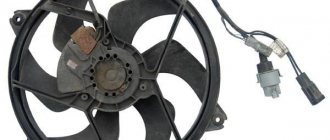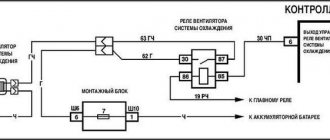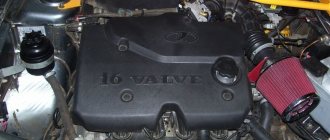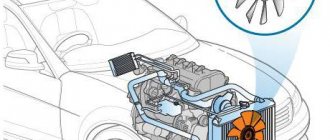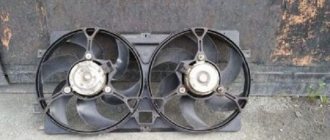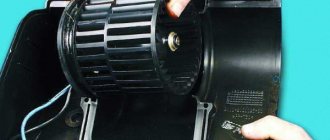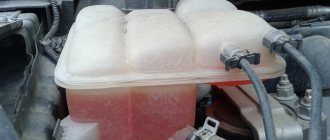Owners of popular Lada Kalina models often encounter situations when the cooling fan does not turn on. This situation forces the driver to periodically stop to allow the engine to cool down. If a malfunction occurs in frosty weather, then it has almost no effect on the functionality of the system, but in warm periods it significantly prevents the LADA Kalina from moving smoothly.
Most Lada Kalina owners are not able to independently diagnose the reasons why the cooling fan does not turn on, much less eliminate them. Tow trucks and services, as well as a switching diagram, are happy to come to their aid.
Replacing the cooling fan Lada Kalina
To replace the cooling fan, it is not necessary to go to a service station. You can do this without much difficulty on your own.
- head with ratchet or socket wrench 10;
- screwdriver with Phillips bit;
- pliers.
spanner or open-end wrench 8;
Work order
- Place the car on a level surface.
- Raise the hood, disconnect the ground wire from the battery.
- Using a 10mm wrench, unscrew the two air filter mounting bolts.
- Disconnect the mass air flow sensor connector by pressing the latch.
- Disconnect the purge valve connector located on the air filter housing.
- Using a screwdriver, unscrew the bolt of the air duct fixation clamp and remove the corrugation.
- Unscrew the 4 screws securing the air filter cover.
- Remove the cover and remove the filter element.
- Using a size 8 wrench, unscrew the nut securing the air intake and remove it.
- Using a size 10 wrench, unscrew the two nuts securing the fan casing on the right in the direction of travel of the car, and then with a size 8 wrench, unscrew the two nuts on the left.
Replacing the SOD fan
Replacing a cooling fan is not the most difficult procedure; the first stage involves preparing the necessary tools:
- 10 mm socket head with wrench;
- wrench (socket or socket) 8 mm;
- figured screwdriver;
- pliers.
The replacement process is as follows:
- To make it easier to dismantle the unit, remove the air filter housing by unscrewing the two mounting bolts.
- Using pliers, disconnect the plastic latch of the expander hose.
- Disconnect the wire connector from the mass air flow sensor (mass air flow sensor) by pressing the latch from below.
- Disconnect the wire connector from the canister purge valve on the air filter box.
- Remove the pipe clamp and move it to the side.
- Unscrew the 4 mounting bolts and remove the housing cover.
- Remove the adsorber by pulling it up.
- Unscrew the air intake mounting nut (near the radiator at the top).
- Remove the rubber cushion near the battery and remove the air filter housing.
- Unscrew the two fastening nuts with a 10 mm wrench on the right side, and then unscrew the two nuts with an 8 mm wrench on the left.
- Disconnect the wire plug from the electric fan.
- Remove the electric fan assembly by moving it to the left.
If the node changes, the procedure is repeated in reverse order. To replace the electric motor, you will need to dismantle it. This is easy to do by unscrewing the three mounting bolts with a 10 mm wrench. On the other hand, you need to disconnect the metal latch and remove the motor with the impeller.
How to replace a fan
Having understood exactly why the cooling fan of the Lada Kalina does not work, you should replace the faulty element. With the proper skills and dexterity, you can perform the repair yourself. The tools you need to prepare are pliers, a screwdriver, wrenches 8 and 10.
First, we place the vehicle on a level surface. Then we lift the hood and disconnect the system from the battery. Using a wrench, disconnect the air filter mounts. Next, you need to disable the mass air flow sensor (just press the latch) and the purge valve, which is located on the air filter housing. Unscrew the clamp bolt and remove the corrugation.
Remove the air filter cover, remove the filter element, and dismantle the air intake. Then we proceed to attach the fan casing and disconnect the power supply to the fan. Having done everything correctly, you can dismantle the fan. We remove the electric motor and then replace it with a new element. Then we put everything back together.
Finally, it is worth checking the functionality of the device. We start the engine and then warm it up for 3-5 minutes. The fan should turn on during this time. There is no need to turn off the car as soon as the fan starts spinning - you should wait until the device turns off automatically.
What if the fan completely stopped working?
To determine the cause of such a malfunction, you first need to check the condition of the fuse in the electrical circuit. It can be found on the side console, near the passenger seat. It is hidden under the deflector cover. By unscrewing the screw, the cover can be easily removed and the fuse will be available for examination.
To remove the entire safety block and connected relays, the mount must be released. You can't do this without wrenches. You need to remove the unit carefully without haste, as you can damage the wires that are connected to it. Only the single fuse of the unit is responsible for the operation of the fan.
If the fuse is intact, it is necessary to check the operation of the relay that powers the fan motor. There are two such relays installed. The left one turns on low fan speed. And the one located on the right is responsible for the high speed of its operation.
Another problem that relates to the cooling fan relay is that the cooling fan continues to operate when the ignition is turned off. This may drain the battery. “Kalina” then simply won’t start. The main reason is sticking contacts. The block is exposed to antifreeze leaking from the radiator installed above the stove.
When the relays and fuses are working properly, you need to check the operation of the temperature sensor. It is he who orders the fan to start working. This sensor is located on the right side of the radiator tank.
To check its functionality, you need to remove the plug connector, take a jumper, and use it to short-circuit the connector terminals. The fan turning on indicates that the sensor is in good condition. If the fan does not react at all, then before changing the sensor, you need to check the functionality of the fan motor. To do this, the electric motor terminals must be connected to the battery contacts. The engine should start working. In case of failure, you will have to install a new electric motor.
Replacing coolant temperature sensors on Kalina
Welcome!
Coolant temperature sensors - if we talk specifically about the Lada Kalina car, then there are only two sensor data in it, one goes to the controller (This is the brain, to put it simply), and the other to the device, that is, one sensor shows what the temperature of the coolant in the car is and displays this is all for the device, and another one (which gives readings to the controller) turns on the cooling system fan when the car is boiling, and also regulates the fuel-air mixture (Simply put, when the car is cold, thanks to this sensor it will warm up faster, because the sensor richens the mixture and the temperature immediately rises), both of these sensors are important and if they fail they will cause quite a lot of trouble, especially for the sensor that gives readings to the device, if it stops working, then you simply will not know the temperature of the coolant and in connection with which you can overheat the engine. Note! To replace both sensors (you will most likely only replace one), stock up on: Wrenches, as well as sockets and a wrench for them, you will also need a multi-meter (This is in case you want to check the functionality of the old sensor ) and a screwdriver!
Where are the coolant temperature sensors located? We would like to immediately note one very important fact, just below we have posted a photo in which we have already indicated with arrows the location of both sensors, but the photo shows a VAZ 2110 car, and you have a Lada Kalina, in general there is not much difference in the engines and these sensors are also on them are located practically in the same places, we just wanted to warn you so that you are not too surprised when you look at your engine, because they may differ slightly, but in general, as already said, they are almost the same, in general the sensor that measures coolant temperature and gives it to the controller, screwed into the thermostat and indicated by a red arrow, the second sensor that gives readings to the device is already indicated by a green arrow, but since it is not visible in the photo, we also indicated with a blue arrow the wire that is connected to this sensor .
When should coolant temperature sensors be replaced? The sensors themselves should last quite a long time, but they don’t always come across high-quality ones, and even literally after a month new sensors already fail, it’s not difficult to understand this, especially if it’s a sensor that goes to the device (the gauge will immediately stop showing the coolant temperature, the arrow will just will lie, for clarity this indicator is indicated by an arrow), but with the sensor that goes to the controller it’s a little more complicated and you won’t even immediately understand that it’s time to change it, well, let’s move on to the symptoms, firstly, if the sensor going to the controller comes in unusable, then the car will consume more gasoline (This is due to the fact that the mixture will always be rich) and the cooling fan will not work when the engine overheats, if you notice all this in your car, then immediately change the sensor to a new one or simply remove the old one and check it (we explained in this article a little lower how both sensors are checked, so read it and you will understand everything as you read).
The cooling fan on Kalina does not turn on, what should I do?
The situation when the cooling fan on Kalina does not turn on is quite common. Such a malfunction can create quite a lot of discomfort, because every 5-10 minutes you will have to brake the car so that the engine cools down. In winter, when the air temperature drops below 10 degrees below zero, this can still be dealt with, but on a hot day, such a problem will lead to serious problems, especially when you need to drive around the city. We’ll talk now about how to solve the problem of the fan not turning on on Kalina.
Description of the fan switch sensor
DTOZH and the fan switch sensor are two different regulators. The DTOZH gives the ECU temperature readings, and the ECU turns on the fan itself. The second regulator, as a rule, is a power regulator, closes the contacts at a certain temperature - turns on the fan relay and is located mainly on the radiator, since the DTOZH is located on the engine.
More details about how the fan sensor works, what functions it has, and how to diagnose this device are below.
Purpose and functions
The radiator fan switch improves the cooling system's properties, including auxiliary air flow without external driver intervention. To perform these manipulations, a special element is installed in the device body that responds to changes in liquid temperature.
Main functional elements of the cooling system
Before you figure out why the Kalina engine cooling fan does not work, you should understand what the cooling system consists of in general. This may include:
- radiator. It is located at the front of the vehicle. The cooling process is carried out using a powerful air flow;
- fan. The device is located on the radiator itself. When the antifreeze temperature reaches a certain value (on viburnum it is 95 degrees), the fan starts working, which speeds up the cooling process;
- temperature sensor. It sends a signal to start the fan when the motor temperature begins to rise;
- expansion tank. Antifreeze reacts very sharply to temperature fluctuations. When it contracts or expands, the expansion tank allows it to compensate for the change in fluid volume;
- water pump. Thanks to the pump, antifreeze circulates throughout the system;
- thermostat. The device is responsible for the process of supplying fluid to the radiator. It is this element that controls and maintains a stable temperature in the power unit.
A breakdown of any device leads to a situation where the cooling fan on the 8-valve Kalina does not work.
Next in the video is a solution to the problem when the cooling fan does not turn on in Kalina:
Features of the system functioning
Simultaneously with the functioning of the system, parts work that allow you to monitor the heating of the oil in the engine, as well as the ambient temperature. In addition, the actuation process is also influenced by a number of vehicle electrical sensors. Only the correct functioning of all these elements leads to the fact that the Kalina fan switch-on sensor performs its functions efficiently.
The movement of the liquid itself also depends on temperature. There are two traffic circles on Kalina: large and small. In the second case, the antifreeze passes by the radiator, at this moment the thermostat is closed. As the temperature rises, the device slowly opens, so that the liquid enters the radiator, where it is cooled by a powerful air flow. When this is not enough, the fan also turns on.
System diagnostics
If Kalina's fan does not turn on, first of all, you should start looking for the problem in the electric motor. To do this, disconnect the wiring, and then connect the device directly to the battery. This way you will know whether there is a problem with the fan, or whether you need to look for another reason for the faulty cooling system.
Next we check the contacts, relay and fuse. They should be found on the additional mounting block, which is located just to the right of the instrument panel. To check the fuse we use a tester. If this does not help solve the problem, look at the temperature sensor. Just warm up the engine, turn off the engine, and then turn off the sensor.
You can find it on the thermostat housing. After disconnecting the sensor, the fan will start in automatic mode. We start the engine. If it warms up and the Kalina cooling fan does not work, we begin to look for broken wiring.
Is there a need to replace the fan?
Having discovered that the problem lies in the fan or electric motor, you can try to repair this element. Mostly, on Kalina 1.6 (8 valves) the cooling fan does not turn on when the brush breaks or the rotor bearings become unusable. Less often, the problem should be looked for in the collector or winding break.
If the device cannot be repaired, the element must be replaced. Do not attempt to drive with a broken fan. Overheating of the engine will automatically lead to rupture of hoses, rubbing of gaskets and malfunction of the pistons.
How to replace a fan
Having understood exactly why the cooling fan of the Lada Kalina does not work, you should replace the faulty element. With the proper skills and dexterity, you can perform the repair yourself. The tools you need to prepare are pliers, a screwdriver, wrenches 8 and 10.
First, we place the vehicle on a level surface. Then we lift the hood and disconnect the system from the battery. Using a wrench, disconnect the air filter mounts. Next, you need to disable the mass air flow sensor (just press the latch) and the purge valve, which is located on the air filter housing. Unscrew the clamp bolt and remove the corrugation.
Remove the air filter cover, remove the filter element, and dismantle the air intake. Then we proceed to attach the fan casing and disconnect the power supply to the fan. Having done everything correctly, you can dismantle the fan. We remove the electric motor and then replace it with a new element. Then we put everything back together.
Finally, it is worth checking the functionality of the device. We start the engine and then warm it up for 3-5 minutes. The fan should turn on during this time. There is no need to turn off the car as soon as the fan starts spinning - you should wait until the device turns off automatically.
How to improve the cooling system
To prevent the question of why the Lada Kalina engine cooling fan does not turn on, you can improve the standard cooling system. There are a couple of options for solving this problem. Most often, a new thermostat is installed, which has six holes. Thanks to this, the engine temperature will be more stable.
To increase the service life of the entire system, it is worth using a special antifreeze filter. In addition, you should also install a furnace valve and an additional pump. As a result, the engine will not overheat in summer, and in winter the cabin will become warmer.
A few final words
We learned how to check the cooling fan on Kalina. Once again I would like to emphasize that the operation of this element is very important for the functioning of the entire vehicle. Under no circumstances should you drive your car if the fan is broken. And if there is a need to get behind the wheel of such a vehicle, be sure to make stops at least every 5 minutes.
Below is a detailed video about the reasons why the engine cooling fan does not turn on on the Lada Kalina:
What will please you with the fan itself?
You need to check both it and the temperature sensor. Let's take a look at the electric fan first. To ensure that the engine is working, its terminals are connected directly to the battery. If it starts, it means everything is fine with the fan. Let's move on to the sensor. Depending on what engine is on your iron horse, the actions will be different:
- For a carburetor:
remove the plug connector of the temperature sensor (it is located, by the way, on the right radiator tank) and connect its terminals with a jumper. The fan started spinning - the sensor is working, the terminals just came off. Left dead - it's time to change the sensor; - When using the injector,
we look for the sensor next to the thermostat and remove the connector from it. If the fan starts spinning, it means that the emergency mode has turned on, and your sensor has already burned out.
Another, and last, reason why the cooling fan on the Kalina does not turn on is an open circuit.
We look for a system diagram in the glove compartment and check all the contacts marked on it, thinking about the actions of people who have improved the cooling system on their Kalina. For example, installing a new thermostat with 6 holes (although you will have to completely redo what was installed at the factory) or installing a furnace faucet with another pump. Investments and work - but after that: there is no risk of getting stuck on the highway and looking for the reason for all of the above. Owners of popular Lada Kalina models often encounter situations when the cooling fan does not turn on. This situation forces the driver to periodically stop to allow the engine to cool down. If a malfunction occurs in frosty weather, then it has almost no effect on the functionality of the system, but in warm periods it significantly prevents the LADA Kalina from moving smoothly.
Most Lada Kalina owners are not able to independently diagnose the reasons why the cooling fan does not turn on, much less eliminate them. Tow trucks and services, as well as a switching diagram, are happy to come to their aid.
Repair of the cooling system on Lada Kalina
On the Lada Kalina car, after the antifreeze temperature reaches 95 degrees, the fan automatically turns on. If it does not turn on, the running engine begins to quickly gain temperature. You have to stop, otherwise the pistons will jam and the engine will break down.
Functional elements of the Kalina cooling system
- Large radiator. Installed in the front part of the Lada Kalina to cool the fluid and reduce the temperature during engine operation. Cooling occurs due to a strong air flow of cold air.
- Cooling Fan. Installed directly on the radiator. Thanks to the fan, the liquid cools much faster.
- Stove radiator. Due to the warm air, the car interior warms up.
- Expansion tank. Since one of the properties of coolant is the ability to respond to temperature fluctuations, a special tank is installed. As antifreeze expands or contracts, it compensates for the amount of coolant in the system.
- Water pump. A special device that circulates coolant throughout the vehicle.
- Thermostat. A very important detail, despite its miniature size. The thermostat regulates the flow of fluid that moves through the engine radiator. The thermostat maintains the optimum operating temperature of the engine.
- Temperature sensor. When the temperature rises above normal, the sensor signals this fan relay to turn on instantly.
How to replace coolant temperature sensors on a VAZ 1117-VAZ 1119?
Removal: 1) These sensors are replaced absolutely identically, but first you need to de-energize the battery, because when working with electronics anything can happen and under no circumstances should there be voltage in the on-board network (Voltage in the on-board network, in other words, in the entire car , can be removed by disconnecting the minus terminal from the battery; for more details on how to do this, read the article:
“Replacing the battery on VAZ cars”, in paragraph 1 everything is written), after the operation has been completed, go further, pick up a screwdriver and use it to loosen the screw (Indicated by a red arrow) which connects one end of the air pipe to the air filter housing, as soon as the screw is loosened disconnect the hose in this place (indicated by a yellow arrow) and put it aside, this will give you good access to both temperature sensors (one is indicated by a green arrow for clarity, this is the one that goes to the controller), by the way, in addition, there is also a screen from the engine remove it if you have one (it is indicated in the photo with a blue arrow), it can be removed quite easily, just take it with your hands on the sides and, using a little force, remove the screen from the car engine.
Note! Some people completely remove the air filter housing so that it does not interfere, so if you see that it is bothering you and without completely removing it, the sensor you need cannot be replaced, then in this case, remove the air filter housing from the car, read the article on how to do this : “Replacing the air filter housing on a VAZ”!
2) Now drain the coolant from the radiator (For information on how to do this, see the article: “Replacing the coolant on a car”), although you don’t have to drain it, but in this case you need sharp hands and a little dexterity (Which path will you choose It’s up to you, but if you don’t want to drain the liquid from the car, then there’s nothing wrong with it, the main thing is that an air lock does not form, and for this you need to do everything quickly), then disconnect the wire block from the sensor you need (see photo 1 and 2) and taking a wrench or a socket wrench in your hands, unscrew the sensor you also need from the hole in which it is screwed (see photos 3 and 4), when the sensor is unscrewed, remove it from the car, in that case if you did not want to drain the liquid from the radiator, then it will immediately flow out as soon as you remove the sensor, so here you need to remove the sensor a little differently (the same dexterity is needed that we talked about earlier), this is all done as follows, in the beginning you use a wrench Use the key to turn the sensor out a little, and when it’s about to turn out, take the new sensor in one hand and remove the key, while you begin to turn the old sensor out a little with your fingers, pressing it at the same time (otherwise liquid will flow through the holes if you don’t press), how As soon as you understand that the sensor is unscrewed and the liquid does not pour out, it is only because you press it, sharply remove it and put a new one in its place, while also pressing, screw in the new sensor little by little and check whether it works or not.
Note! Photos 1 and 3 above show the sensor going to the controller, while photos 2 and 4 show the sensor going to the device, so be careful!
Installation: The new sensor is installed in its place in the reverse order of removal; when installing, you can lubricate it with sealant so that liquid does not leak through it; in addition, you can check the functionality of the old sensor, for this, prepare a multi-meter and a kettle with a thermometer and a mug, then put the kettle on and wait until it boils or just warms up a little, then pour water into a mug and throw the sensor in there, but just make sure you don’t drown it with the contacts, otherwise it will immediately stop working (the sensor needs to be thrown in exactly the same way as shown in the photo below , in this photo you can clearly see that the contacts of the sensor are not in the water but on the top and thus nothing will happen to the sensor), as soon as the work is done, pick up a multi-meter and connect the leads coming from it to the sensor (Black wire throw it to minus, that is, more simply put, on the metal part of the sensor body, and connect the other, red wire, to the sensor contact), after which the multi-meter should give readings (see. table under the photo below, checking the thermometer and the readings of the device, the readings should be exactly the same or very slightly different as indicated in the table) in connection with which you will determine whether your sensor is working or not.
New Lada: Jerks at low speeds and when starting off Lada Kalina
Note! The above described check was carried out on a temperature sensor, which gives readings to the controller, as for the sensor that gives readings to the device, in principle they are checked absolutely identically, but the values may be different when you check them, so pay special attention to this don’t worry, just check if the temperature changes when the sensor cools down and when it heats up, if it changes, then everything is fine, if it doesn’t change or changes by a very small value, then replace the sensor with a new one, because yours has already become unusable , oh, by the way, you can also check the sensor without lowering it into any water, in this case, just stand on the street and know the ambient temperature, check the sensor and check the table, if everything fits, go into the room and there is exactly the same Perform the same check by connecting the device, but without lowering the sensor into any water. If the device gives correct readings in the room at a certain temperature, then the sensor is working and does not need to be replaced!
Additional video: There are simply no videos on the Internet on replacing the coolant temperature sensor on Lada Kalina cars, so we took a video on replacing the same sensor but only on another car, namely a VAZ 2110, the principle of replacement on both of these cars are almost identical and there is not much difference between them.
How the cooling system works
This system works in conjunction with a wide variety of parts that measure:
- heating the engine oil;
- ambient temperature.
In addition, the operation of the system largely depends on a variety of electrical sensors included in the electrical circuit of the Kalina. Thanks to the joint work of all these parts, the cooling fan relay is automatically turned on on the Kalina car. Automation monitors the operation of the entire system and ensures the best cooling of the engine.
Temperature affects the movement of fluid. Kalina has two movements:
When the fluid moves in a small circle, it bypasses the radiator. At this time, the thermostat is closed. As soon as the temperature of the power unit begins to increase, the thermostat slowly opens. The path to the radiator is opened for coolant. Here it is cooled due to a powerful flow of oncoming air. If such cooling is not enough, the fan switch sensor will work, it will turn on and begin forced cooling.
How to check the sensor yourself?
Checking the fan switch sensor is not difficult.
- If there is a need to diagnose it, you must first find out its functions and operating principle.
- After this, you can test the system by heating the most vulnerable part of the sensor housing. To do this, you need to remove it from the radiator, carefully inspect it, check the contact pads, inspect the wires, and, if necessary, clean it.
- Next, you will need a tool that you can make yourself from a regular light bulb and battery, or use a special tester.
- Bring water to a boil, then connect the tester and sensor contacts and lower its vulnerable side into the water.
- After this, a short circuit should occur. This action will cause the lamp to ignite, or the characteristic sound signal of the tester to appear. If the device shows that the contacts closed before colliding with boiling water, then the sensor is undoubtedly faulty. The author of the video, Mechanical Technician, will tell you how to check the fan switch sensor.
Cooling system malfunctions
First of all, this is due to antifreeze leakage. This malfunction is clearly visible under the hood of the car. In most cases, fluid leakage from the system occurs due to:
- lack of tightness on the pipes.
- clamps are outdated;
- the heating radiator is clogged;
- The cooling radiator is broken.
The heating radiator will have to be replaced, but a large radiator can be repaired. You just need to solder the holes. But it must be remembered that it is mainly the copper radiator that is soldered. The aluminum radiator installed on Kalina is rarely repaired. It is better to immediately replace it with a new one.
In case of constant overheating of the car engine, the first place is due to malfunctions of the cooling system:
- Thermostat. To check it, you need to warm up the engine. Use your hand to touch the pipes leading to the radiator. When the top pipe is completely cold, while the bottom pipe is slightly warm, we can talk about the thermostat being stuck. In this case, the liquid moves in a small circle. There is only one way to fix the problem - you need to install a new thermostat.
- The radiator honeycombs are completely closed. A common cause of abnormal operation of the cooling system. In most cases, this happens at the beginning of summer, when poplar fluff begins to fly. To get everything back to normal, you need to clean the outside of the radiator. Sometimes such work causes certain difficulties, but this is the only way to make the system work properly. You have to do manual work.
- The fan is broken. When the heating temperature exceeds 95 degrees and the fan is silent, several parts need to be checked:
- cooling fan relay;
- electrical wiring;
- sensor
After detecting problems, a new relay and sensor are installed, and the wires are replaced.
Operating temperature of 8-valve
The normal operating temperature for eight-valve engines on Kalinas and Grants is exactly 90 ºC . But owners complain that sometimes it has difficulty reaching 80 degrees even in warm weather. The reason lies in the thermostat - it opens fully at a temperature of 85 degrees. Moreover, the permissible deviation from this value is very large - ( 85±8.3 ) ºС.
In other words, the run-up is 77..93ºС .
But the fuel mixture can only ignite normally if the engine temperature is about 90 degrees . This is the value stored in the electronic control unit. If the temperature is too low, the mixture becomes richer (the amount of gasoline increases). This is the main problem that occurs when the temperature drops. And in winter the heater works worse.
Your case
Temperature diagram . Normal operating temperature is at 90 on the instrument panel.
In your case, the thermostat is most likely stuck, usually stuck in the middle. In this case, either repairing or replacing the thermostat will help.
A stuck thermostat valve is a typical malfunction of the engine cooling system.
That is, the liquid that has not yet been heated is supplied to the cooling radiator and blown by a strong wind flow. Indeed, with an increase in air temperature, the problem will partly go away. That’s why they used to put cardboard on it and drive like that for years. But we don't recommend doing this.
Solution
The problem of low temperature of the engine cooling system can be eliminated by installing a thermostat that opens at 92ºС . The WAHLER 3091.92D element performs excellently .
You just have to disassemble it and transfer the inside to Kalina’s original thermostat.
There is a downside: in summer the temperature will be higher, and there is a risk of boiling in a traffic jam. To be more precise, this risk is higher when installing a thermostat with a late opening time!
Be sure to use new gaskets and lubricate them with a small amount of sealant - this will prevent coolant leaks.
Air lock: features
"Kalina", like hundreds of other cars, is in no way protected from the appearance of an air lock. It cuts off the coolant supply. Solving this problem often involves some difficulties.
For a novice motorist who owns a Lada Kalina, an air lock is always a problem. To deal with it, you first need to remove the cap from the expansion tank. Then heat the engine to a temperature at which the gauge needle begins to reach the red zone. When the fan turns on, you need to press the accelerator pedal several times and turn off the ignition. Sometimes this is enough. The air lock completely disappears.
However, if the plug remains, more specific measures must be taken:
- The plastic screen is being dismantled;
- the clamp is released;
- the tube is removed from the fitting located on the throttle assembly;
- the expansion tank opens, its neck must be closed with a rag;
- Air is supplied to the open expansion tank until liquid begins to pour out of the tube. If it was not possible to break through the air plug in this way, you need to close the lid and return the removed tube to its place.
- then you need to warm up the engine again and turn off the ignition;
- remove the heating tube, but do not remove the cover. You need to wait a little until the liquid begins to pour out of the tube.
Since coolant is a toxic substance, this operation must be performed very carefully. Safety precautions require gloves.
During operation, you need to check the temperature of the tubes. The engine must be completely cool.
After draining the liquid, the tube is put on the fitting and tightened with clamps. Thus, the air from Kalina will be completely removed. This work can be done by any motorist; the help of a specialist is not needed. In order for Kalina to be free from such problems, it is necessary to constantly check the tightness of all connections and tighten the clamps.
Replacement with draining antifreeze
If you discover that the device is not functioning correctly or is completely inoperable, you need to replace it with a new one. To perform dismantling, you must follow the instructions:
- If the engine is hot, it must be allowed to cool;
- De-energize the vehicle ground by disconnecting the negative terminal of the battery;
- Remove the expansion tank cap;
- Remove the radiator cap;
- To prevent contamination, it is necessary to place a container under the drain hole;
- Drain the antifreeze from the radiator. There is no need to drain antifreeze from the cylinder block. To unscrew the drain plug, just a hand is enough, so no tools are needed;
- When the liquid stops flowing out, you should return the plug to its place to avoid its loss;
- Remove the terminal with wires;
- Use a wrench to carefully unscrew the sensor.
To install a new sensor you must:
- Check the condition of the copper sealing washer. In most cases, it will require replacement with a new one. Using an old gasket is fraught with antifreeze leaks;
- Screw in the new sensor, making sure that the sealing washer fits evenly;
- Connect the terminals with wires;
- Pour antifreeze into the expansion tank. If the drained antifreeze is of good quality, you can return it. Otherwise, fresh fluid must be used;
- To eliminate air pockets in the cooling system, it is necessary to purge it;
- Replace the radiator cap;
- Close the expansion tank;
- Connect the negative terminal of the battery;
- Warm up the engine until the sensor responds.
If after these steps the fan does not turn on when the required temperature is reached, it is necessary to continue troubleshooting in other possible places. Before continuing to search for a breakdown, it is advisable to read the error log from the ECU using a diagnostic scanner.
What if the fan completely stopped working?
To determine the cause of such a malfunction, you first need to check the condition of the fuse in the electrical circuit. It can be found on the side console, near the passenger seat. It is hidden under the deflector cover. By unscrewing the screw, the cover can be easily removed and the fuse will be available for examination.
To remove the entire safety block and connected relays, the mount must be released. You can't do this without wrenches. You need to remove the unit carefully without haste, as you can damage the wires that are connected to it. Only the single fuse of the unit is responsible for the operation of the fan.
If the fuse is intact, it is necessary to check the operation of the relay that powers the fan motor. There are two such relays installed. The left one turns on low fan speed. And the one located on the right is responsible for the high speed of its operation.
Another problem that relates to the cooling fan relay is that the cooling fan continues to operate when the ignition is turned off. This may drain the battery. “Kalina” then simply won’t start. The main reason is sticking contacts. The block is exposed to antifreeze leaking from the radiator installed above the stove.
When the relays and fuses are working properly, you need to check the operation of the temperature sensor. It is he who orders the fan to start working. This sensor is located on the right side of the radiator tank.
To check its functionality, you need to remove the plug connector, take a jumper, and use it to short-circuit the connector terminals. The fan turning on indicates that the sensor is in good condition. If the fan does not react at all, then before changing the sensor, you need to check the functionality of the fan motor. To do this, the electric motor terminals must be connected to the battery contacts. The engine should start working. In case of failure, you will have to install a new electric motor.
Checking and replacing the Kalina cooling fan resistor
Removing the additional fan resistor is done as follows:
- put the car on the “handbrake”;
- open the hood;
- remove the ground wire from the battery;
- remove the engine splash guard;
- unscrew and remove the engine crankcase protection (if installed);
- press the block latch and unplug the electric fan power supply wiring harness;
- Using a Phillips screwdriver, unscrew the two screws holding the additional resistor;
- move aside the resistor mounting bracket together with the block;
- pull out the resistor.
Checking the resistor consists of two stages:
- visual inspection of the integrity of the spiral;
- checking the resistor winding for open circuit using an ohmmeter.
If a winding malfunction is detected, the resistor must be replaced with a new one. If the thermal fuse is faulty, then all you can do is replace it. To do this, you will need a soldering iron to remove the burnt fuse and solder a new one in its place. All that remains is to put the parts in their original places. Installation of the Kalina cooling fan resistor is carried out strictly in the reverse order of removal.
The radiator fan of the engine cooling system of the Lada Kalina passenger car should turn on automatically when the coolant temperature reaches more than 95 degrees. And if this does not happen, then the engine begins to overheat and the driver’s failure to take timely measures to reduce the temperature (switching to idle speed) leads to jamming of the pistons in the engine cylinders.
Start troubleshooting
associated with a fan failure, you need to check the integrity of the fuse protecting this electrical circuit. It is located on the side of the console near the front passenger's feet. To get to it, you need to unscrew one screw securing the cover with deflectors designed to supply warm air to the passenger’s feet.
But you can remove the additional fuse and relay block only after you unscrew the bolt securing it, for which you will need a 10mm wrench. You need to take it out carefully and slowly so as not to damage it, since the bundle of wires suitable for it is very in the way . There is only one fuse in the block, exactly the one you need.
If the fuse is intact, then you can immediately check the serviceability of the relays through which voltage is supplied to the fan motor. There are two of these relays: the leftmost one above the mounting bar is designed to turn on a low fan speed, and the rightmost one is designed to turn on a high fan speed.
Another malfunction associated with the fan relay is that the fan continues to operate after the ignition is turned off, and if you leave the car in the parking lot without paying attention to it, the battery will discharge, which will lead to problems with starting the Kalina engine. Sticking of the relay contacts occurs due to antifreeze entering this block as a result of its leakage from the heater radiator.
If everything is in order with the fuse and relay, then you will have to open the hood and check the serviceability of the temperature sensor, which commands the fan to turn on. It is located on the right radiator tank. To check its functionality, simply remove the plug connector from it and close the connector terminals with a jumper. If the fan starts working, then the sensor is working, and if it doesn’t work, then before drawing a conclusion that the sensor is faulty, you need to check the serviceability of the fan motor itself. To do this, you will need to connect the motor terminals directly to the battery terminals.
Modern domestically produced cars are equipped with various controllers and sensors that ensure full operation of the car. If one of the devices fails, this can lead to incorrect operation of the nodes. From this material you can find out what the Priora and Kalina fan switch is and what malfunctions are typical for it.
[Hide]
Some improvements to the Kalina water cooling system
Today, drivers use several methods to upgrade the cooling system. For example, the factory cooling system is completely redone. At the same time, Kalina is equipped with a completely new thermostat with six holes. Thus, the coolant temperature becomes more stable. The cabin becomes much warmer.
To reduce the likelihood of failure of the cooling system, the Lada Kalina is equipped with a special filter through which coolant is supplied.
The installation of a furnace tap is also ideal. In addition, an additional pump is installed in the fluid supply system. As a result, antifreeze will move quickly through the channels, in winter the Kalina will receive enhanced heating, and in summer the engine will never overheat.
